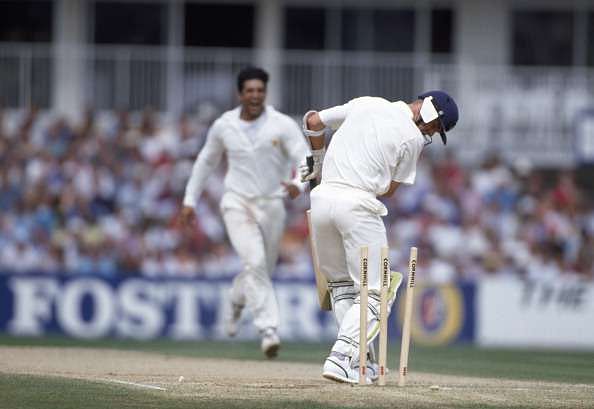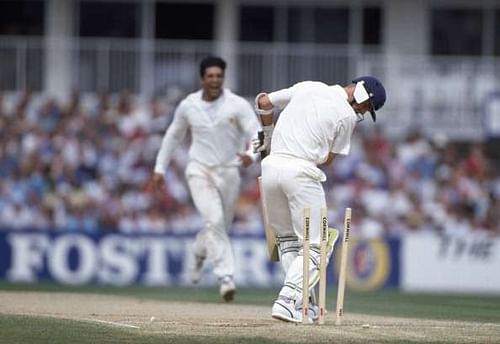
SK Glossary: What is reverse swing in cricket?
Reverse swing, as the name suggests is exactly the opposite of conventional swing. Before going into the complexities of reverse swing, we need to understand how a cricket ball swings. When a cricket ball wobbles in the air and changes direction sideways, it is known as swing. A cricket ball has two sides separated by a seam. The bowlers are advised to hold the seam with their two fingers to generate swing. Let's discuss normal conventional swing first. The two types of swings are the outswing and the inswing. An outswinger is delivered with the intention of swinging the ball away from the batsman (say a right handed batsman here) and an inswinger is bowled with a plan to bring the ball back in.
Now, let's imagine a right arm bowler trying to bowl an outswinger with the new ball. The seam of the ball is held by the bowler in such a way that, upon its release the seam should point towards the slips. He also keeps the shinier side of the new ball towards the right. Since there are lesser wear and tear on the new ball, the bowler is able to generate swing by aligning the seam in the desired direction and releasing the ball a proper wrist position.
Hence, the wrist position and direction of the seam are key factors for generating early swing with the new ball. Reverse swing is exactly the opposite where the old ball swings to the direction of the shiny side that is if the shiny side is towards the right of the seam, the ball swings back into the batsman. Let's see why this happens.
How do you generate reverse swing and the reason behind it?
When the ball becomes old, there is a shift in the aerodynamics of a cricket ball. The seam becomes asymmetrical, the rough side of the ball becomes rougher with time. The other side is polished using saliva and sweat and that these liquids manage to change the texture of the ball and increases the non-uniformity between the two sides of the ball.
When the ball starts travelling in the air, the shinier side travels faster than the rougher side and the ball deviates in the air accordingly. Since the shinier side of the ball experiences less friction through the air, the ball moves in the direction of the shiny side.
For example, when a bowler wants to bring the ball back into a right-hander with reverse swing, he holds the shiny side towards his right and the ball tails back in very late into the batsman. This is exactly the opposite of conventional swing.
When does reverse swing happen?
Reverse swing happens with an older ball. When the ball starts getting old, the players start shining just one side of the ball and allow the other side to get scuffed-up. You would usually see fielders vigorously working on the ball and trying to rub one side of the ball on their trousers. This is done mainly to exploit reverse swing.
An old ball usually starts reversing after 35 odd overs but it is completely dependent on the conditions. We can't really say for certain that a ball will start reversing after a certain number of overs. Reverse swing is dependent on a lot of external factors. Some of the factors that expedite reverse swing are given below.
If the pitch conditions are abrasive :
The idea here is to get one side of the ball roughed up. This happens quickly if the pitch is an abrasive one. The fast bowlers start banging the new ball on the pitch and also bowl a lot of cross-seamers (they hold the ball across the seam) to roughen the ball up. The fielders continue to shine one side and the ball starts reversing pretty quickly.
If the outfield is dry and rough :
Every time the ball runs across the turf it becomes scuffed up and that results in wear and tear on the surface of the ball. The fielding side uses these conditions to their advantage in a bid to generate early reverse swing. If the outfield is lush green, the ball reverses quite late.
From a batsman's point of view, facing reverse swing can be one of the most difficult challenges in cricket especially when he is up against a fast bowler. When a ball starts reversing, the deviation through the air is generally quite late and that gives the batsman hardly any time to adjust his technique to cater for the late swing.
If the batsman has already committed himself to play for an outswinger and the ball reverses in late then it makes him a candidate for LBW and bowled. When a bowler normally has a notion that reverse swing is available for him, he normally hides the ball at the back of his palm while running into the bowl. This way he doesn't give the batsman an idea beforehand where the shiny side of the ball is.
The origin of reverse swing and the greatest exponents of this art
Reverse swing is said to have been invented in Pakistan. Sarfaraz Nawaz is credited for bringing this phenomenon into international cricket but according to Shahryar Khan, reverse swing was invented by a former Pakistani club bowler Salim Mir. Mir taught this art to his club mate Sarfaraz Nawaz. Nawaz later introduced this art to his team-mate Imran Khan.
The greatest advocates of reverse swing, however, were the next generation of bowlers from Pakistan. The two Ws, Wasim Akram and Waqar Younis, who were known as the “Sultans of swings” mainly because of their ability to reverse an older ball.
Wasim Akram was sometimes unplayable with the prodigious swing he used to generate with the old ball. Waqar Younis was feared by many for his toe-crushing inswinging yorkers. Among modern-day cricketers, Zaheer Khan at his peak was excellent with the older ball.
The English duo of James Anderson and Stuart Broad are well known for bowling brilliantly with the older ball. Dale Steyn, the South African fast bowler, is also quite a handful when the ball starts reversing.
